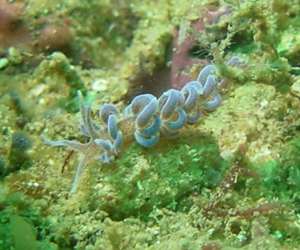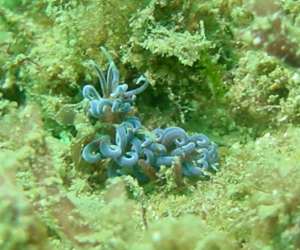Re: Phyllodesmium from Jervis Bay
October 7, 2005
From: Sue Newson


Hi Bill,
I just read a previous message [#14901] posted by Paul Osmond asking for an ID on a Phyllodesmium species from Jervis Bay. I have seen this nudibranch on several occasions over the years. This is a photo of the most recent sighting of it.
Locality: Jervis Bay, New South Wales, Australia. Depth: 17 m. Length: 10 mm. 23 September 2005. rocky reef. Photographer: Sue Newson
On this occasion there were five individuals in the same spot. They have been seen on the rocky reefs from both the south and north sides of the bay. Each occasion I have seen them, have been in a 15 - 20 m depth range. I have always identified them as Phyllodesmium serratum.
Sue Newson
suenewson@optusnet.com.au
Newson, S.T., 2005 (Oct 7) Re: Phyllodesmium from Jervis Bay. [Message in] Sea Slug Forum. Australian Museum, Sydney. Available from http://www.seaslugforum.net/find/14934Dear Sue,
The genus Phyllodesmium is very interesting because the species show almost evry stage in the evolution from 'normal' animals which get their nutrition solely from the food they eat to solar powered 'plant animals' which keep single-celled plants alive in their bodies, and get some of their nutrition from the photosynthetic activity of the plants. We can therefore use the morphological adaptations, if any, the animals have for this symbiosis, as a way of identifying them from one another. In typical P. macphersonae, as well as the yellow and white-tipped cerata, there are brown patches all over the body wall and the ceratal wall, which represent small 'gardens' of plant cells [zooxanthellae]. They are not so clear in yours, or Paul Osmond's photos, but if you look at Eric Schloegl's photo [#4250] they are clearly visible. Phyllodesmium serratum on the other hand is one of the species which does not contain zooxanthellae, so it can't be that. At this stage I have considered this animal to be a temperate water form of P. macphersonae, which is found throughout the tropical Indo-west Pacific.
I am intersted to hear you find it not uncommonly. It is the only species around here that I have been unable to find what it feeds on. Finding a number of animals in one spot sounds promisng. It is most likely feeding on a species of soft coral, and as I suspect it obtains its zooxanthellae from its soft-coral food, the soft coral is likely to be dark brown, or grey in colour or to have dark specks. Next time you come across the animal I would love some close-up photos, especially if it is on a soft coral.
Best wishes,
Bill Rudman
Related messages
-
Re: Phyllodesmium macphersonae from sthn Queensland
From: Gary Cobb, August 8, 2008 -
Phyllodesmium macphersonae from sthn Queensland
From: Gary Cobb, August 6, 2008 -
Phyllodesmium macphersonae from Jervis Bay
From: Leander Wiseman, February 22, 2006 -
Phyllodesmium macphersonae? from Jervis Bay, NSW, Australia
From: Paul Osmond, October 5, 2005 -
Phyllodesmium macphersonae - first feeding record
From: John Chuk, January 25, 2002 -
Phyllodesmium macphersonae? from Japan
From: Nishina Masayoshi, September 20, 2001 -
Phyllodesmium macphersonae from Sydney
From: Erik Schloegl, April 30, 2001
